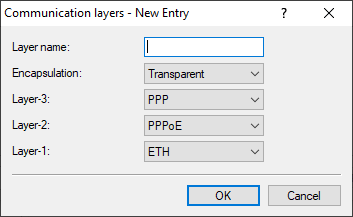A layer defines a collection of protocol settings to be used for connecting to specific remote sites. The list of communication layers can be found under:
LANconfig:
Console:
The communication layer list includes predefined common protocol combinations. Changes or additions should only be made if the remote sites are incompatible with the existing layers. The possible options are shown in the following overview.
Important: Please note that the parameters available on the device depend on its functionality. Your device may not offer
all the options described here.

- Layer name
- The layer is selected by this name in the remote site lists.
- Encapsulation
-
Additional encapsulations can be set for the data packets:
- Transparent
- No additional encapsulation.
- Ethernet
- Encapsulation as Ethernet frames.
- LLC-ETH
- Ethernet over ATM with LLC encapsulation according to RFC 2684.
- LLC-MUX
- Multiplexing over ATM with LLC/SNAP encapsulation according to RFC 2684. Multiple protocols can be transmitted within the same VC (Virtual Channel).
- VC-MUX
- Multiplexing over ATM by creating additional VCs according to RFC 2684.
- Layer-3
-
The following options are available for the network layer (Layer 3):
- Transparent
- No additional header is added.
- PPP
- The connection is established according to the PPP protocol (in synchronous mode, i.e., bit-oriented). Configuration data is taken from the PPP table.
- DHCP
- Assignment of network parameters via DHCP.
- DHCP (Broadcast Flag)
- The connection is established using a DHCP client with the broadcast flag set in DHCP.
- Layer-2
-
This field configures the upper part of the Data Link Layer (Layer 2). The following options are available:
- Transparent
- No additional header is added.
- PPPoE
- Encapsulation of PPP protocol information into Ethernet frames.
- Layer-1
-
This field configures the lower part of the Data Link Layer (Layer 1). The following options are available:
- ETH
- Transparent Ethernet according to IEEE 802.3.
- WWAN
- For connections via the internal WWAN modem.
- XDSL
- For connections via the internal DSL modem.
